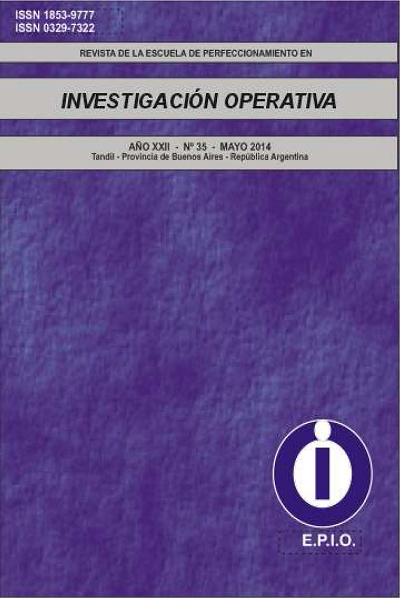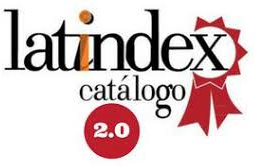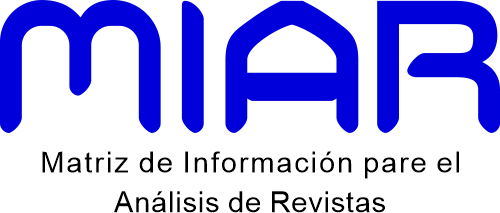Conocimiento en accion: asignacion de recursos a familias carentes mediante la aplicación de un algoritmo genético - Proyecto Koinonia
Palabras clave:
gestión del conocimiento, algoritmo genético, optimización, asignación de recursos, sistema de soporte a las decisionesResumen
El proyecto Koinonía surge como iniciativa de Caritas de una parroquia de Tandil (Bs. As.-Argentina) y tiene como objetivo crear un conjunto de herramientas de gestión y ayuda a la toma de decisiones en la acción social que realiza dicha institución.
En su accionar, Caritas entrega un bolsón de alimento mensual a cada una de un conjunto de familias beneficiarias.
Ante esta realidad se evidencia el problema de realizar una asignación eficiente de los bienes disponibles para conformar un bolsón de alimentos que satisfaga la mayor cantidad de necesidades de cada grupo familiar.
El presente trabajo contempla la aplicación de un algoritmo genético cuyos principios fueron establecidos por Holland (1975) y que responde a la selección natural descripta por Darwin (1859), con la variante de que cada individuo es una asignación completa de recursos al grupo de familias asistidas y cada necesidad se instrumenta como las aptitudes que tienen los individuos. De esta forma los individuos compiten por los recursos y se resuelve el problema de asignación de los mismos con métodos adaptativos de búsqueda y optimización.
Descargas
Referencias
BUENO, M.; DOS REIS, M.; ILLESCAS, G.; TRIPODI, G.; VALLEJOS I.; MÉNDEZ CASARIEGO I. (2010): “CONOCIMIENTO EN ACCIÓN: RANKING DE FAMILIAS SEGÚN NECESIDADES BÁSICAS INSATISFECHAS – PROYECTO KOINONÍA”. II ERABIO, XXIII ENDIO, XXI EPIO. Septiembre de 2010, UNCPBA, Tandil, Buenos Aires, Argentina.
BUENO, M.; DOS REIS, M.; ILLESCAS, G.; TRIPODI, G.; VALLEJOS, I.; MÉNDEZ CASARIEGO I. (2011): “CONOCIMIENTO EN ACCIÓN: MÉTODOS DE ASIGNACIÓN DE ALIMENTOS A GRUPOS FAMILIARES. PROYECTO KOINONÍA”. Revista EPIO Nº 32. Marzo 2011.
BREMERMANN, M. F. (1962): “OPTIMIZATION THROUGH EVOLUTION AND RECOMBINATION”. Self Organizing Systems. M. C. Yovits, G. T. Jacobi, and G. D. Goldstein (eds). Spartan Books, Washington D. C.
CARITAS. SITIO WEB: http://www.caritas.org.ar
CARITAS KOINONIA. SITIO WEB: http://www.caritaskoinonia.org.ar
DAVIS, L. (1991): “THE HANDBOOK OF GENETIC ALGORITHMS”. Van Nostrand Reinhold, New York.
DARWIN, C. R. (1859): “ON THE ORIGIN OF SPECIES BY MEANS OF NATURAL SELECTION OR THE PRESERVATION OF FAVOURED RACES IN THE STRUGGLE FOR LIFE”. London. J. Murray.
DE JONG, K. A. (1975): “ANALYSIS OF BEHAVIOUR OF A CLASS OF GENETIC ADAPTIVE SYSTEMS”. Tesis Doctoral. The University of Michigan. Technical Report N° 185, pp. 48-53.
FOGEL, L. J., OWENS, A. J.; WALSH, M. J. (1966): “ARTIFICIAL INTELLIGENCE THROUGH SIMULATED EVOLUTION”. John Wiley.
FRASER, A. S. (1957): “SIMULATION OF GENETIC SYSTEMS BY AUTOMATIC DIGITAL COMPUTERS”. Australian Journal Biological Sciences (10), pp. 484-499.
FRIEDBERG, R. M. (1958): “A LEARNING MACHINE: PART I”. IBM Journal (2), pp. 2-13.
FRIEDBERG, R. M.; DUNHAM, B.; NORTH, J. H. (1959): “A LEARNING MACHINE: PART II”. IBM Journal (2), pp. 282-287.
GOLDBERG, D. E. (1989): “ZEN AND THE ART OF GENETIC ALGORITHMS”. Proceedings of the 3rd International Conference on Genetic Algorithms, pp. 80-85.
HOLLAND, J. H. (1969): “ADAPTATIVE PLANS OPTIMAL FOR PLAYOFFONLY ENVIRONMENTS”. Proceedings of the 2nd Hawai International Conference on System Sciences, pp. 917-920.
HOLLAND, J. H. (1975): “ADAPTATION IN NATURAL AND ARTIFICIAL SYSTEMS”. University of Michigan. Ann Arbor.
ILLESCAS, G.; BUENO, M. E.; DOS REIS, M. R.; XODO, D.; PÉREZ, C. D.; RECOFSKY, E.; WEIMANN, R. H. (2013): “OPTIMIZACIÓN EN LA ASIGNACIÓN DE RECURSOS. INDICADORES DE TRANSICIÓN DE LA DECISIÓN A LA ACCIÓN”. Anales XXVI ENDIO – XXIV EPIO. ISBN en trámite. Mayo 2013. Córdoba. Argentina.
MITCHELL, T. (1997): “MACHINE LEARNING”. McGraw-Hill. New York. USA.
ROTHLAUF, F. (2006): “REPRESENTATIONS FOR GENETIC AND EVOLUTIONARY ALGORITHMS”. Springer-Verlag Berlin Heidelberg, pp. 9- 31.
SCHWEFEL, H. P.; MÄNNER, R. (1991): “PARALLEL PROBLEM SOLVING FROM NATURE”. Proceedings of the 1st Workshop PPSN I. Springer, Berlin, pp. 307-313.
Descargas
Publicado
Número
Sección
Licencia
Atribución — Usted debe dar crédito de manera adecuada, brindar un enlace a la licencia, e indicar si se han realizado cambios. Puede hacerlo en cualquier forma razonable, pero no de forma tal que sugiera que usted o su uso tienen el apoyo de la licenciante.
NoComercial — Usted no puede hacer uso del material con propósitos comerciales.
CompartirIgual — Si remezcla, transforma o crea a partir del material, debe distribuir su contribución bajo la misma licencia del original.







